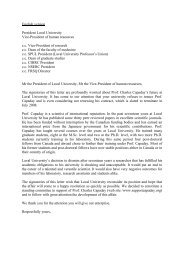Untitled - Laboratory of Neurophysics and Physiology
Untitled - Laboratory of Neurophysics and Physiology
Untitled - Laboratory of Neurophysics and Physiology
You also want an ePaper? Increase the reach of your titles
YUMPU automatically turns print PDFs into web optimized ePapers that Google loves.
tigated whether eCBs could also promote long-term potentiation, an essential requirement for eCBs<br />
to be a genuine bidirectional system <strong>and</strong> to fully encode for learning <strong>and</strong> memory.<br />
To this aim, we combined in vitro spike timing-dependent plasticity (STDP) protocols in rodents <strong>and</strong><br />
a biophysical model <strong>of</strong> the signaling pathways likely to be involved. The model describes the temporal<br />
dynamics <strong>of</strong> three main signaling systems: the postsynaptic NMDAR-CaMKII pathway (adapted from<br />
[1]), the postsynaptic mGluR-PLCβ system (adapted from [2]) as well as postsynaptic eCB synthesis<br />
<strong>and</strong> subsequent activation <strong>of</strong> postsynaptic TRPV1 <strong>and</strong> presynaptic CB1R in a retrograde fashion.<br />
Using the model to drive the experiments, we uncovered the existence <strong>of</strong> an eCB-mediated spiketiming<br />
dependent potentiation (eCB-LTP). This eCB-LTP is homosynaptic, astrocyte-independent<br />
<strong>and</strong> expressed in young <strong>and</strong> adult animals <strong>and</strong> across various brain regions (cortex <strong>and</strong> striatum), supporting<br />
its role as a widespread signaling system for spike-based plasticity. We deciphered the signaling<br />
pathways (pre- <strong>and</strong> postsynaptic receptors <strong>and</strong> enzymes) involved in this new form <strong>of</strong> plasticity <strong>and</strong><br />
demonstrated that eCB plasticity has a postynaptic induction <strong>and</strong> a presynaptic maintenance. On the<br />
postsynaptic side, our results show that the dynamics <strong>of</strong> free cytosolic calcium is a key element for<br />
eCB-LTP induction. eCB-LTP is triggered when eCB transients reach sufficiently high levels. Since the<br />
enzymes that synthetize eCBs are calcium-activated, eCB-LTP induction requires large levels <strong>of</strong> cytosolic<br />
calcium. On the presynaptic side, eCBs encode for bidirectional plasticity via a triad composed<br />
<strong>of</strong> eCB levels, presynaptic PKA <strong>and</strong> presynaptic CaN: intermediate eCB levels promote presynaptic<br />
CaN activity, that yields eCB-LTD, whereas large eCB amplitudes favor presynaptic PKA activity,<br />
which leads to eCB-LTP. Both effects are predicted to rely on the inhibition exerted by activated<br />
CB1R on presynaptic adenylate cyclase <strong>and</strong> P/Q-type voltage-gated calcium channels. Moreover, we<br />
show that eCB-LTP <strong>and</strong> eCB-LTD can be induced sequentially in the same neuron, depending on the<br />
cellular conditioning paradigm. Therefore, our results demonstrate that eCBs, just like glutamatergic<br />
or GABAergic signaling, form a generic system able to encode for bidirectional plasticity <strong>and</strong> capable<br />
<strong>of</strong> genuine homeostasis.<br />
Lastly, we found that eCB-LTP is triggered by very few paired spikes (5 to 10 post-pre spikes at 1<br />
Hz are enough). Thus, eCB-LTP provides synapses with a mechanism able to react to the very first<br />
occurrences <strong>of</strong> incoming activity. This ability strongly contrasts with NMDAR-dependent LTP which,<br />
in a classical (1 Hz) STDP context, requires the iteration <strong>of</strong> at least 75-100 paired stimulations to be<br />
expressed, at odds with the observations that new associative memories <strong>and</strong> behavioral rules can be<br />
learned within few or even a single trials in mammals (e.g. [3]). Our results suggest that eCB-LTP<br />
may represent a neuronal substrate for such rapid learning abilities.<br />
References<br />
1. Graupner M, Brunel N: STDP in a bistable synapse model based on CaMKII <strong>and</strong> associated signaling<br />
pathways. PLoS Comput Biol 2007, 3:e221<br />
2. De Pittá M, Goldberg M, Volman V, Berry H, Ben-Jacob E: Glutamate regulation <strong>of</strong> calcium <strong>and</strong> IP3<br />
oscillating <strong>and</strong> pulsating dynamics in astrocytes. J Biol Phys 2009, 35:383-411.<br />
3. Pasupathy A, Miller EK: Different time courses <strong>of</strong> learning-related activity in the prefrontal cortex<br />
<strong>and</strong> striatum. Nature 2005, 433:873-876.<br />
55



